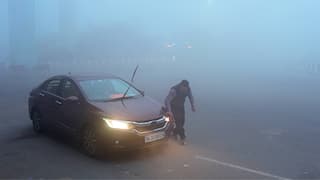Lancet Study Lists 10 Scientific Reasons To Support That Covid-19 Is Primarily An Airborne Disease
In a study funded by WHO, researchers listed 10 scientific reasons which support that Covid-19 is predominantly airborne while dismissing the current understanding of the disease. India reported 234,692 Covid-19 cases on Saturday, the highest single-day spike so far since the pandemic broke out, according to MoHFW.

New Delhi: In a study published in the Lancet, have listed out reasons why SARS-CoV-2 is primarily an airborne diease while dismissing the current understanding that the diease spreads through smaller aerosols that stay suspended in air or through fomites which fall on surfaces and that since gravity pulls down heavier droplets it reduces the chances of infection. According to the researcher "if an infectious virus is mainly airborne, an individual could potentially be infected when they inhale aerosols produced when an infected person exhales, speaks, shouts, sings, sneezes, or coughs."
"Ten streams of evidence collectively support the hypothesis that #SARS-CoV-2 is transmitted primarily by the airborne route."
— The Lancet (@TheLancet) April 16, 2021
New Comment from @trishgreenhalgh, @kprather88, @jljcolorado, @zeynep, @dfisman, and Robert Schooley. #COVID19 https://t.co/2z8jLEcOPH
ALSO READ: List Of Restrictions From Various States During The Weekend
- Superspreading events account for most cases of Covid-19 transmission. Detailed analyses of human behaviours and interactions, room sizes, ventilation are consistent with airborne spread of SARS-CoV-2 and the same cannot be adequately explained by droplets or fomites.
- The study states that, "long-range transmission of SARS-CoV-2 between people in adjacent rooms but never in each other's presence has been documented in quarantine hotels".
- Atleast a third or upto 59% of the world's transmission are accounted for by asymptomatic or presymptomatic people, those who aren't coughing or sneezing. According to the study, speaking creates aerosols and few larger droplets. Asymptomatic or presymptomatic people "could be a key way SARS-CoV-2 has spread around the world".
- Transmission of SARS-CoV-2 is higher indoors than outdoors and is reduced by indoor ventilation, this supports that the disease is primarily airborne.
- Cases that have originated from hospitals where thorough protocols are followed show that the disease is airborne; "use of personal protective equipment (PPE) designed to protect against droplet but not aerosol exposure," say the study.
- Laboratory experiments found that SARS-CoV-2 stayed in the air for upto 3 hours. "Viable SARS-CoV-2 was identified in air samples from rooms occupied by COVID-19 patients in the absence of aerosol-generating health-care procedures and in air samples from an infected person's car". While sampling of airborne virus is technically challenging they argued that, "measles and tuberculosis, two primarily airborne diseases, have never been cultivated from room air".
- The study said, "SARS-CoV-2 has been identified in air filters and building ducts in hospitals with COVID-19 patients; such locations could be reached only by aerosols".
- Quoting studies involving infected caged animals that were connected to separately caged uninfected animals showed the transmission of SARS-CoV-2 via an air duct this can only be explained by aerosols.
- Scientists argues that no studies have refuted this hypothesis or airborne transmission. "Some people have avoided SARS-CoV-2 infection when they have shared air with infected people, but this situation could be explained by a combination of factors, including variation in the amount of viral shedding between infectious individuals by several orders of magnitude and different environmental (especially ventilation) conditions," the study further stated.
- Researchers argued that there was limited evidence to support other dominant routes of transmission- i.e. respiratory droplet or fomite. "It is sometimes argued that since respiratory droplets are larger than aerosols, they must contain more viruses. However, in diseases where pathogen concentrations have been quantified by particle size, smaller aerosols showed higher pathogen concentrations than droplets when both were measured," they further said in the paper.
Based on these reasons, the scientists said that, "reducing airborne transmission of virus requires measures to avoid inhalation of infectious aerosols, including ventilation, air filtration, reducing crowding and time spent indoors, use of masks whenever indoors, attention to mask quality and fit, and higher-grade protection for health-care staff and front-line workers. Airborne transmission of respiratory viruses is difficult to demonstrate directly".
Check out below Health Tools-
Calculate Your Body Mass Index ( BMI )
Calculate The Age Through Age Calculator






































